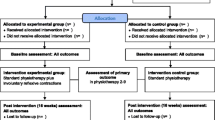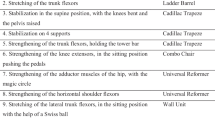Abstract
The aim of this article is to give an overview of the exercise science related to pelvic floor muscle (PFM) strength training, and to assess the effect of PFM exercises to treat stress urinary incontinence (SUI). Sixteen articles addressing the effect of PFM exercise alone on SUI were compiled by computerized search or found in other review articles. Studies with no statement that correct PFM contraction had been performed were excluded. Kegel's suggestion was to perform 3–500 PFM contractions per day. However, suggestions for effective strength training from the exercise science is 8–12 contractions in three series 3–4 times a week for 15–20 weeks or more. Frequency of training varies between 10 repetitions every waking hour to half an hour 3 days a week. Holding periods vary between 2 and 3 s and 30–40 s. Exercise periods vary between 3 weeks and 6 months. Only a few research groups have used methods to measure PFM strength that were reproducible and valid. Statistically significant strength increase has been found after PFM exercise lasting from 3 to 6 months. In all studies the exercises were conducted with thorough individual instruction, vaginal palpation, feedback and close follow-up. Self-reported cure and success rates vary between 17% and 84%. Statistically significant improvement has been demonstrated on self-grading instruments, urethral closure pressure during cough, resting urethral pressure, functional urethral profile length, leakage episodes and pad tests with standardized bladder volume. The results of the long-term studies are promising. It is therefore concluded that PFM exercises are effective in treating SUI. They are cost-effective and should be the first choice of treatment. To be effective, PFM exercise has to be thoroughly taught and performed with weekly or monthly follow-up.
Similar content being viewed by others
References
Kegel AH. Progressive resistance exercise in the funcational restoration of the perineal muscles.Am J Obstet Gynecol 1948;56:238–249
Kegel AH. Physiologic therapy for urinary incontinence.JAMA 1951;146:915–917
Abrams P, Blaivas JG, Stanton SL, Andersen TJ. The standardization of terminology of lower urinary tract function.Scand J Urol Nephrol 1988 (Suppl)114:5–19
Enhørning G. Simultaneous recording of intravesical and intraurethral pressure.Acta Chir Scand 1961;276 (Suppl):1–48
Koelbl H, Bernascheck G, Wolf G. A comparative study of perineal ultrasound scanning and urethrocystography in patients with genuine stress incontinence.Arch Gynecol Obstet 1988;244:39–45
Hanzal E, Berger E, Koelbl H. Levator ani muscle morphology and recurrent genuine stress incontinence.Obstet Gynecol 1993;81:426–429
Beco J, Sulu M, Schaaps JP, Lambotte R. A new approach to the troubles of urinary incontinence in women: urodynamic ultrasound examination by the vaginal route.J Gynecol Obstet Biol Reprod 1987;16:987–998
Ulmsten U, Ekman G, Giertz G, Malmstrøm A. Different biochemical composition of connective tissue in continent and stress incontinent women.Acta Obstet Gynecol Scand 1987;66:455–457
DeLancey JOL. Anatomy and mechanics of structures around the vesical neck: how vesical neck position night affect its closure.Neurouroul Urodyn 1988;7,3:161–162
Constantinou CE, Govan DE. Contribution and timing of transmitted and generated pressure components in the female urethra. In: Female incontinence. New York: Allan R Liss, 1981:113–120
Åstrand PO, Rodahl K. Textbook of work physiology: Physiological bases of exercise. McGraw Hill Company, 1986.
Chritchley HOD, Dixon JS, Gosling JA. Comparative study of the periurethral and perianal parts of the human levator ani muscle.Urol Int 1980;35:226–232
Kegel AH. Stress incontinence and genital relaxation.Ciba Clin Sympos 1952;2:35–51
Bø K, Stien R. Needle EMG registration of striated urethral wall and pelvic floor muscle activity patterns during cough, Valsalva, abdominal, hip adductor, and gluteal muscle contractions in nulliparous healthy females.Neurourol Urodyn 1994;13:35–41
Bø K, Kvarstein B, Hagen R, Larsen S. Pelvic floor muscle exercise for the treatment of female stress urinary incontinence: II. Validity of vaginal pressure measurements of pelvic floor muscle strength and the necessity of supplementary methods of control of correct contraction.Neurourol Urodyn 1990;9:479–487
Bø K, Hagen R, Kvarstein B, Larsen S. Female stress urinary incontinence and participation in different sport and social activities.Scand J Sports Sci 1989;11:117–121
Bø K, Stien R, Kulseng-Hanssen S, Kristoffersen M. Clinical and urodynamic assessment of nulliparous young women with and without stress incontinence symptoms: a case control study.Obstet Gynecol 1994;84:1028–1032
Nygaard I, DeLancey JOL, Arnsdorf L, Murphy E. Exercise and incontinence.Obstet Gynecol 1990;75:848–851
American College of Sports Medicine Position Stand. The recommended quantity and quality of exercise for developing and maintaining cardiorespiratory and muscular fitness in healthy adults.Med Sci Sports Exerc 1990;22:265–274
Plevnik S. A new method for testing and strengthening of pelvic floor muscles. Proceedings of the 15th Annual General Meeting, International Continence Society 1985;267–268
Bø K. Vaginal weight cones. Theoretical framework, effect on pelvic floor muscles strength and female stress urinary incontinence.Acta Obstet Gynecol Scand 1995;74:87–92
Hahn I. Pelvic floor training for genuine stress urinary incontinence. Doctoral thesis, University of Gothenburg, Sweden, 1993
DiNubile NA. Strength training.Clin Sports Med 1991;10,1:33–62
Sale DG. Neural adaptation to resistance training.Med Sci Sports Ex 1988;20:135–145
Bø K. Physical activity, fitness and bladder control. In: Bouchard C, Shephard RJ, Stephens T (eds). Physical activity, fitness & health. Champaign, IL: Human Kinetics Publishers 1994;774–795
Wells TJ. Pelvic (floor) muscle exercise.JAGS 1990;38:333–337
Wall LL, Davidson G. The role of muscular reeducation by physical therapy in the treatment of genuine stress urinary incontinence.Obstet Gynecol Surv 1992;47,5:322–331
Wallace K. Female pelvic floor functions, dysfunctions, and behavioral approaches to treatment.Clin Sports Med 1994;13,2:459–481
Bø K, Larsen S, Oseid S, Kvarstein B, Hagen R, Jørgensen J. Knowledge about and ability to correct pelvic floor muscle exercises in women with urinary stress incontinence.Neurourol Urodyn 1988;7,3:261–262
Hesse U, Schussler B, Frimberger J, Obernitz N v, Senn E. Effectiveness of a three step pelvic floor reeducation in the treatment of stress urinary incontinence: a clinical assessment.Neurourol Urodyn 1990;9,4:397–398
Hendrickson LS. The frequency of stress incontinence in women before and after the implementation of an exercise program.Issues in Health Care Women 1981;3:81–92.
Kujansuu E. The effect of pelvic floor exercises on urethral function in female stress urinary incontinence: a urodynamic study.Ann Chir Gynecol 1983;72:28–32
Burgio KL, Robinson JC, Engel BT, The role of biofeedback in Kegel exercise training for stress urinary incontinence.Am J Obstet Gynecol 1986;154:58–64
Benvenuti F, Caputo GM, Bandinelli S, Mayer F, Biagini C, Somavilla A. Reeducative treatment of female genuine stress incontinence.Am J Phys Med 1987;66,4:155–168
Hennalla SM, Kirwan P, Castleden DM, Hutchins CJ, Breeson AJ. The effect of pelvic floor muscle exercises in the treatment of genuine stress incontinence in women at two hospitals.Br J Obstet Gynaecol 1988;95:81–92
Tapp AJS, Cardozo L, Hills B, Barnic C. Who benefits from physiotherapy?Neurourol Urodyn 1988;7,3:260–261
Bø K, Hagen RH, Kvarstein B, Jørgensen J, Larsen S. Pelvic floor muscle exercise for the treatment of female stress urinary incontinence: III. Effects of two different degrees of pelvic floor muscle exercises.Neurourol Urodyn 1990;9:489–502
Burns PA, Pranikoff K, Nochajski T, Desotelle P, Harwood K. Treatment of stress urinary incontinence with pelvic floor exercises and biofeedback.JAGS 1990;38:341–344
Ferguson KL, McKey PL, Bishop KR, Kloen P, Verheul JB, Dougherty MC. Stress urinary incontinence: effect of pelvic muscle exercise.Obstet Gynecol 1990;75:671–675
Cammu H, Van Hylen M, Derde MP, Debruyne R, Amy JJ. Pelvic physiotherapy in genuine stress incontinence.Urology 1991;38,4:332–337
Lagro-Janssen TLM, Debruyne FMJ, Smits AJA, Van Weel C. Controlled trial of pelvic exercises in the treatment of urinary stress incontinence in general practice.Br J Gen Prac 1991;41:445–449
Hahn I, Naucler J, Sommar S, Fall M. Urodynamic assessment of pelvic floor training.World J Urol 1991;9:162–166
Hahn I, Sommar S, Fall M. A comparative study of pelvic floor training and electrical stimulation for treatment of genuine female stress urinary incontinence.Neurourol Urodyn 1991;10:545–554
Dougherty M, Bishop K, Mooney R, Gimotty P, Williams B. Graded pelvic muscle exercise. Effect on stress urinary incontinence.J Reprod Med 1993;38,9:684–691
Elia G, Bergman A. Pelvic muscle exercises: when do they work?Obstet Gynecol 1993;81:283–286
Ramsey IN, Thou M. A randomized, double blind, placebo controlled trial of pelvic floor exercises in the treatment of genuine stress incontinence.Neurourol Urodyn 1990;9,4:398–399
Klarskov P, Nielsen KK, Kromann-Andersen B, Maegaard E. Long-term results of pelvic floor training for female genuine stress incontinence.Int Urogynecol J 1991;2:132–135
Mouritsen L, Frimodt-Møller C, Møller M. Long term effect of pelvic floor exercise on female urinary incontinence.Br J Urol 1991;68:32–37
Hahn I, Milson J, Fall M, Eklund P. Long-term results of pelvic floor training in female stress urinary incontinence.Br J Urol 1993;72:421–427
Bø K, Talseth T. Long term effect of pelvic floor muscle exercise 5 years after cessation of organized training.Obstet Gynecol 1995 (submitted for publication)
Bump RC, Hurt WG, Fantl JA, Wyman JF. Assessment of Kegel exercise performance after brief verbal instruction.Ann J Obstet Gynecol 1991;165:322–329
Wilson PD. Conservative management of urethral sphincter incompetence.Clin Obstet Gynecol 1990;33:330–345
Thorp JM, Stephenson H, Jones LH, Cooper G. Pelvic floor (Kegel) exercises — a pilot study in nulliparous women.Int Urogynecol J 1994;5:86–89
Lose G. Simultaneous recording of pressure and cross-sectional area in the female urethra: a study of urethral closure function in healthy and stress incontinent women.Neurourol Urodyn 1992;11,2:54–89
Bø K. Adherence to pelvic floor muscle exercise and long term effect on stress urinary incontinence. A five year follow up.Scand J Sports Med Sci 1995;5:36–39
Kerrebroeck Ph.EV. Clinical evaluation versus urodynamic analysis in female urinary incontinence.Int Cont Surv 1992;2:2–3
Kralj B. Comparative study of pad tests — reliability and repetitiveness.Neurourol Urodyn 1989;8:305–306
Lose G, Rosenkilde P, Gammelgaard J, Schroeder T. Pad weighing test performed with standardized bladder volume.Urology 1988;32:78–80
Author information
Authors and Affiliations
Additional information
EDITORIAL COMMENTS: Dr Bø presents a thorough review of pelvic floor exercies for the treatment of stress urinary incontinence. The concepts of exercise physiology, important to the teaching and performance of pelvic floor exercises, are clearly defined. Unfortunately, investigators in this area of research have utilized disparate therapy regimens, various methods to determine pelvic floor muscle strength and different outcome measures of success, making meta-analysis of the results impossible. It is clear that pelvic floor exercises are a viable treatment option for patients with stress incontinence. However, optimum success from any treatment regimen requires patient motivation, thorough instruction to perform the exercises correctly, and long-term follow-up to ensure adherence to training.
Rights and permissions
About this article
Cite this article
Bø, K. Pelvic floor muscle exercise for the treatment of stress urinary incontinence: An exercise physiology perspective. Int Urogynecol J 6, 282–291 (1995). https://doi.org/10.1007/BF01901527
Issue Date:
DOI: https://doi.org/10.1007/BF01901527




